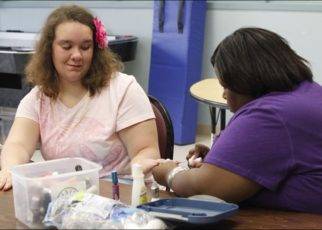This observance, founded by the Autism Society in the 1970’s, is the perfect opportunity for both adults and kids to learn about the special needs of those in their community who have autism.
Early Identification of Autism Symptoms
Autism is a developmental disability that exists on a spectrum, meaning that different people may have the disorder to different degrees. According to the Centers for Disease Control and Prevention, autism is present in about 1 in every 110 births.
While there is no cure for autism, the disorder is treatable. Since early intervention is critical to successful treatment, the earlier a diagnosis is made, the better. Typically, parents notice something unusual about their child before the age of three. According to The Autism Society, parents should be on the alert for the following possible symptoms in their young children:
Lack of or delay in spoken language
Repetitive use of language and/or motor mannerisms (e.g. hand flapping, twirling objects)
Little or no eye contact
Lack of interest in peer relationships
Lack of spontaneous or make believe play
Persistent fixation on parts of objects
Autism Society Programs
The Autism Society supports research and provides programs and initiatives to support people with autism. One such initiative is the Safe and Sound Program. This program provides resources on emergency preparedness and prevention. One of the components of the program helps to provide training to law enforcement and first responders regarding how to interact appropriately and helpfully with people with autism.
The Safe and Sound program also offers an emergency decal that can be placed on the car window or door of a person with autism. The decal also comes with a Personal Information Record, which would provide necessary emergency information to first responders. These would be perfect tools for parents to obtain to help keep kids and teens with autism safe in the event of an emergency.
Teens can also help people with autism by helping to advocate for them. The Vote4Autism site provides links that allow users to connect directly with their public officials regarding current political issues affecting people with autism.
Teens who feel strongly about issues such as healthcare reform, exposure to toxic chemicals (thought to contribute to autism), greater financial independence for people with autism, and keeping autistic students safe, can use this site not only to voice their opinions on these important subjects, but can help get other teens on board, as well.
Promoting Autism Awareness
Teens can update their Facebook or Twitter status to “Autism affects 1 in 110. Text AUTISM to 50555 to donate $10 to The Autism Society.” 100% of these donations will go to helping people with autism.
Kids can also show their support by wearing the Autism Awareness Ribbon. These are available as pins, magnets, awareness bracelets, and Facebook badges.
Those with questions or concerns about autism can call 1-800-3AUTISM, a toll free information and referral service.
Autism Awareness Month is a great time for kids to gain a greater understanding of people with autism. Greater awareness can lead to greater understanding and tolerance of those who may be different.





